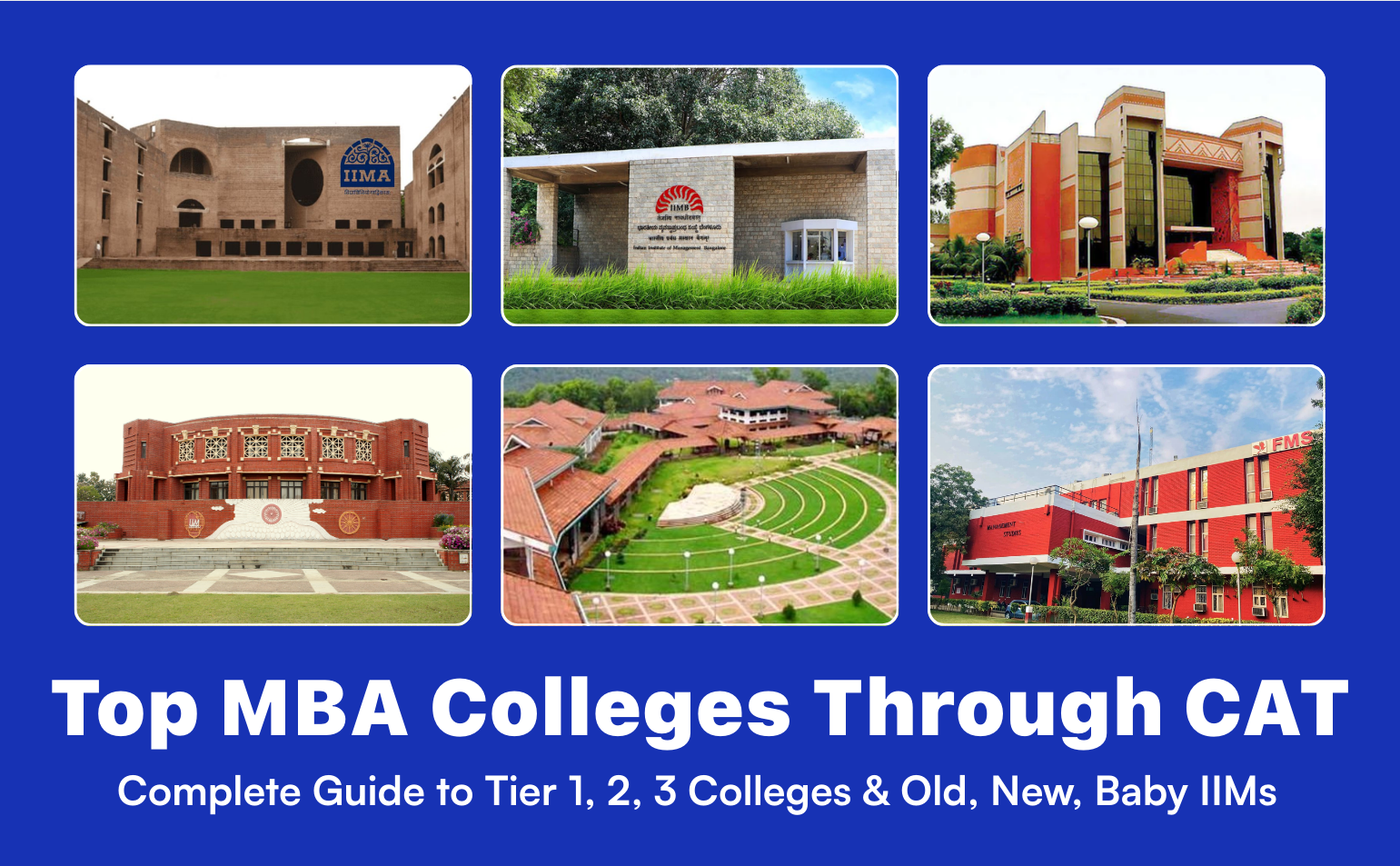The CAT exam, known for its high difficulty level, is a gateway to numerous top-tier B-schools across India. Around 70-80% of MBA institutions accept CAT scores for admissions. In addition to the IIMs, prestigious MBA colleges such as FMS Delhi, MDI Gurgaon, JBIMS, TISS, and others also consider CAT scores. If you aim for an MBA, understanding which colleges you can target through your CAT score is crucial for planning, preparation, and success.
This article will evaluate these institutions based on educational quality, fees, reputation, and placement opportunities. We will decode the Tier 1, 2, and 3 MBA colleges, including the Old, New, and Baby IIMs, so you can make an informed choice based on your profile, percentile expectations, and career aspirations.
| Why CAT Matters for MBA Aspirants?CAT is the most prestigious MBA entrance exam in India. Conducted annually by one of the IIMs, it opens doors to over 20 IIMs and 100+ top B-schools across the country. Scoring well in CAT can define the trajectory of your professional life. |
Tier-wise Classification of MBA Colleges Through CAT
MBA colleges in India are often categorized into Tier 1, Tier 2, and Tier 3 based on factors like brand value, placement records, alumni network, infrastructure, ROI (Return on Investment), and academic rigor.
Top MBA colleges in the Tier 1 category through CAT include prestigious institutions like FMS Delhi, IIT Delhi, JBIMS, TISS Mumbai, and more. In the Tier 2 category, you’ll find colleges such as Great Lakes Chennai, IMT Ghaziabad, and IMI Delhi, among others.
Explore the complete list of top MBA colleges to consider for admission.
Top Tier 1, 2 and 3 Colleges for MBA
Complete Old, New & Baby IIM List
IIM Ahmedabad, IIM Calcutta, IIM Bangalore, and IIM Lucknow are among the leading MBA institutions in India. Explore the complete list of IIMs nationwide, including old, new, and baby IIMs.
Which College Should You Target?
Choosing a B-school isn’t just about your CAT score. Consider:
- Your Academic Profile
- Work Experience
- Career Goals
- Location Preferences
- Specializations (Finance, Marketing, HR, etc.)
- ROI and Placement Packages
Final Thoughts – Strategic CAT Preparation
Your CAT score is your ticket, but your strategy defines the destination. Start with a clear vision of where you want to be, and align your preparation accordingly.
At Tarkashastra, we help students ace the exam and make informed decisions about their future. Whether your dream is IIM Ahmedabad or a practical option like K J Somaiya, we’re here to guide you every step of the way.
Get Started With Your MBA Journey
- Explore our CAT 2025 coaching programs
- Book a free counselling session
- Download our CAT strategy planner
Success isn’t about getting into a college. It’s about getting into the right one for you.
Frequently Asked Questions
- What Is the CAT Exam, and Why Is It Important for MBA Admissions?
The Common Admission Test (CAT) is a national-level management entrance examination conducted by the Indian Institutes of Management (IIMs) on a rotational basis. It serves as the primary gateway to the 21 IIMs. It is also accepted by over 100+ top-tier B-schools in India, including FMS Delhi, SPJIMR, MDI Gurgaon, and others.
CAT tests candidates in three core areas:
- Quantitative Ability (QA)
- Verbal Ability and Reading Comprehension (VARC)
- Data Interpretation and Logical Reasoning (DILR)
The CAT is critical because of the breadth of institutes it opens doors to and the prestige and career-defining opportunities associated with the institutions that use it for admissions.
- How Do IIMs (Indian Institutes of Management) Fit Into the CAT Admissions Process?
The IIMs are the founding institutions behind CAT; hence, it is primarily their selection tool. Each IIM releases its own shortlist criteria based on the following:
- Overall and sectional CAT percentiles
- Academic profile (10th, 12th, graduation marks)
- Work experience
- Diversity (academic and gender)
Once shortlisted, candidates must go through Written Ability Tests (WAT), Group Discussions (GD), and Personal Interviews (PI) as part of the final selection. While the older IIMs are more selective, newer and baby IIMs provide a broader access spectrum for 85–95 percentile students.
- What Are Tier 1, Tier 2, and Tier 3 MBA Colleges, and How Do They Differ From Each Other?
MBA colleges in India are categorized into tiers based on their academic reputation, placement quality, infrastructure, and alumni networks. Tier 1 colleges, such as older IIMs and FMS Delhi, are highly prestigious, with excellent placements and global recognition. Tier 2 colleges, like IMT Ghaziabad and IMI Delhi, provide good academics and placements but are generally considered a step below Tier 1 institutions. Tier 3 colleges are usually newer or regional institutions with evolving infrastructure and moderate placements.
- How Does the CAT Exam Help Determine the Tier of an MBA College?
The CAT exam score acts as a benchmark in determining the tier of colleges students can target. Tier 1 colleges typically demand very high CAT percentiles (usually 95% and above), while Tier 2 colleges consider candidates with slightly lower scores (80-95%). Tier 3 colleges often accept students with CAT scores below 80%, thus making CAT a key determinant in choosing the right college.
- What Is the Role of the CAT Score in Getting Admission to Tier 1, 2, and 3 Colleges?
CAT scores serve as a filtering criterion for admission processes across different tiers. Tier 1 colleges heavily rely on high CAT scores alongside academics and interviews. Tier 2 colleges moderately emphasize CAT scores but also strongly consider other criteria. Tier 3 colleges have relatively lenient CAT requirements, focusing more on overall profiles than solely scores.
- What Are the Differences Between Old, New, and Baby IIMs?
Old IIMs, established before 2000 (such as Ahmedabad, Bangalore, and Calcutta), hold the highest prestige with established infrastructure, extensive alumni networks, and strong placements. New IIMs, founded between 2008 and 2011, like IIM Ranchi and Shillong, are rapidly developing with improving placements. Baby IIMs, set up after 2015, are newer institutions building their reputations and industry connections.
- What makes old IIMs (Like IIM Ahmedabad, IIM Bangalore, and IIM Calcutta) stand out From new and baby IIMs?
Old IIMs stand out due to their longstanding heritage, established brand reputation, experienced faculty, and robust alumni networks. They consistently offer top-tier placements, significantly superior to New and Baby IIMs, which are still developing these strengths.
- Are Baby IIMs Worth Considering for My MBA, or Should I Aim for Old/New IIMs?
Baby IIMs can be valuable if location, affordability, or specific programs match your needs. However, for broader career opportunities, networking advantages, and superior placements, Old or New IIMs might be preferable due to their established industry presence and brand recognition.
- What Kind of Salary Packages Can I Expect From Tier 1 vs. Tier 2 vs. Tier 3 MBA Colleges?
Typically, Tier 1 colleges offer the highest salaries, averaging between INR 20-35 lakhs per annum, with top placements even higher. Tier 2 colleges offer moderately high average salaries ranging from INR 10-20 lakhs annually. Tier 3 colleges usually see average packages of around INR 5-10 lakhs annually.
- Do Companies Differentiate Between Tier 1 and Tier 2 MBA Colleges During Recruitment?
Companies often distinguish between graduates from Tier 1 and Tier 2 MBA colleges during recruitment. Tier 1 graduates typically access higher-level positions, better compensation, and more prestigious companies. However, exceptional candidates from Tier 2 colleges can also achieve similar opportunities based on performance and skill.
- How Do the Placement Statistics at Baby IIMs Compare to Old and New IIMs?
Placement statistics at Baby IIMs are improving annually but generally lag behind Old and New IIMs. Old IIMs lead with consistently higher average packages and placements in prestigious companies. New IIMs show competitive placement improvements, while Baby IIMs have moderate packages and placement diversity, gradually catching up.
- What Is the CAT Cutoff for Tier 1 MBA Colleges, and How Does It Vary by Year?
CAT cutoffs for Tier 1 colleges usually range from 95 to 99 percentile, with minor variations annually based on exam difficulty and applicant pool quality. Highly reputed institutions like older IIMs often maintain consistently high cutoffs, whereas other Tier 1 colleges might have slightly fluctuating requirements.
- What Additional Criteria Are Considered by MBA Colleges Apart From CAT Scores (e.g., Work Experience, Academic Background)?
Besides CAT scores, MBA colleges evaluate candidates on their academic performance, work experience, personal interviews, group discussions, and extracurricular activities. Tier 1 colleges often emphasize well-rounded profiles, whereas Tier 2 and Tier 3 colleges might weigh these criteria differently based on their specific admission policies.
- How Do the Selection Processes of Old, New, and Baby IIMs Differ From Each Other?
Old IIMs typically have rigorous, multi-stage admission processes emphasizing high CAT scores, strong academic backgrounds, and significant work experience. New IIMs have moderately demanding processes with flexibility in academic profiles. In contrast, Baby IIMs generally employ simpler selection processes to develop diverse student batches.
- Which College Is Best for an MBA After CAT?
IIM Ahmedabad is considered the top choice for pursuing an MBA in India. It stands out as the leading institution among all the Indian Institutes of Management.
- Which Are the Top Non-IIM Colleges Under CAT?
Some top non-IIM colleges accepting CAT scores include FMS Delhi, MDI Gurgaon, IIT Bombay, JBIMS, and others. FMS Delhi is particularly noted for offering one of the best MBA programs with affordable fees.
- How Much Should I Score in the CAT to Get Admission to a Top MBA College?
Aim for the highest possible score to increase your chances of admission to top-tier MBA colleges. For Tier 1 colleges, including the leading IIMs, FMS, and MDI, a CAT percentile of 95 or above is recommended. However, with a percentile above 90, you can still gain admission to other prestigious MBA institutions across India.







